
© John R. Bentley 2008.
September 2008.
The New Taig Lathe Carriage
A welcome upgrade...
While browsing through the Lee Valley Tools store in Halifax one day, I "accidentally" filled out a purchase form for the new extruded and anodized Taig carriage, which comes complete with the new ball bearing leadscrew assembly, a toolpost and a new rack (plus rack protector).
OK - I didn't need those last two extras, but they are nice parts to have on stock - either for use in making new machines and accessories or simply for replacement parts. I see some possibilities for the new carriage. As you may know, it has a nice wide (but shallow) horizontal dovetail on the face of the front apron as well as a standard Taig T-slot across the bottom of the rear apron.
Surely there are some interesting possibilities here. The new front dovetail might lend itself to several quick-removal accessories, such as a motor drive for either the rack wheel or cross slide, or to attach a complete half-nut mechanism for a leadscrew. No holes to drill!
This page shows some pictures of the new unit, just out of the box as well as my own initial observations and conclusions.
There is nothing official here - in fact, to my knowledge Taig Tools has made no mention of this new development either on their website or magazine advertising. Like the latest headstock version recently introduced, this extruded and anodized carriage has appeared entirely without fanfare, as with so many improvements the company has made to their products over the years.
The colors of the new cross slide and carriage match much more closely
(now that both are anodized)
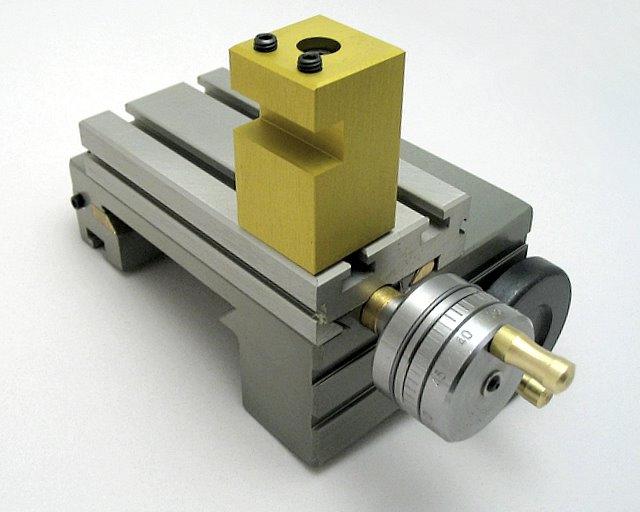
Carriage travel is now even greater than the lathe centre height - at last!
The older travel distance is just under two inches - enough to face a 3.875" diameter disk. The new travel is a hair over 2 1/2" which means it is now possible to face up to a 5" disk continuously (using risers), leaving no telltale change in finish. They have achieved this extra travel at both ends - the bearing is further out to the front and the leadscrew and dovetail are longer. This was the honourable way to go, as it keeps the slide equally engaged in the dovetail at both ends of the travel. In addition, the carriage saddle is 1/4" longer as is the dovetail.
The carriage saddle is also wider as well, which gives better support (especially for milling with the vertical slide - or if anybody decides to make a vertical milling head mounted to the slide). The extra support also won't do any harm if attaching a heavy stereo microscope. The extra width causes a 1/4" reduction in carriage travel. This is the second reduction as a result of Taig's design upgrades - the addition of that funny brass collar on the tailstock ram in the 1980's now prevents it from withdrawing as far as it used to and costs Taig users at least another 1/4" of between-centres distance. Taken in combination, these reductions are starting to limit the length of material that can be turned at a single setting.
The extruded carriage is 1/4" wider and 1/4" longer than the cast version

Eagle eyes will probably spot the hole for the rollpin in the tread of the big wheel. Presumably it enters a hole in the shaft for an absolute connection. You'd have to be pretty smart to get it out of there however.
Notice that Taig didn't provide a locknut for the handwheel eccentric bushing on my carriage. I have seen some pictures on the internet of early models of this carriage which included the nut. Perhaps it was deemed no longer necessary since it is going into less slippery material than the cast carriage which was very likely made from ZA-12 bearing alloy or some similar zinc/aluminum alloy.
Here is an interesting twist - larger gib screws with side setscrews for locking
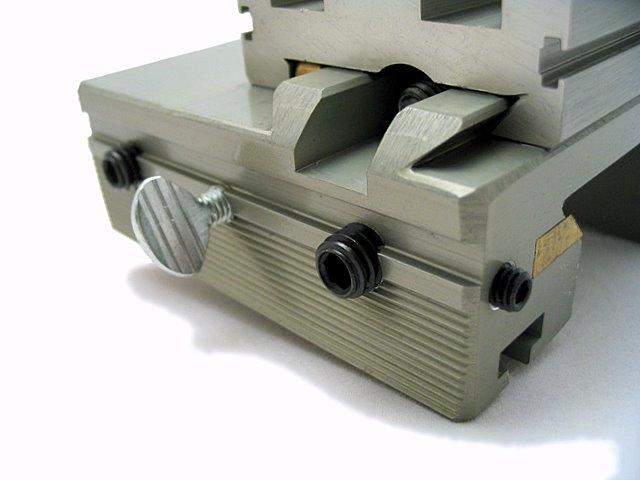
These replace the old style 4-40's with locknuts. The new bigger screws are special - they are threadless on their inner ends to accommodate the side-entering setscrews. Notice the straight slot, unfortunately grazed by the gib screws and carriage lock thumbscrew. Still, it could serve to position or steady something with small "feet" that would use the clear portions of the slot. Check out that monster T-slot underneath!
The changes here are not quite so obvious
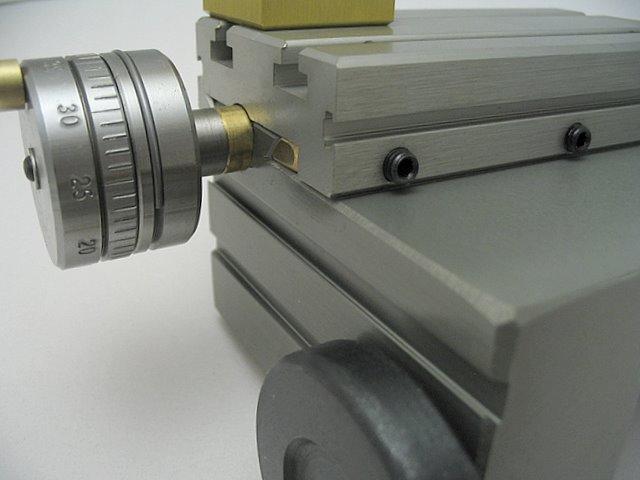 The handwheel bearing block now contains a ball bearing assembly inside and is mounted out farther for greater forward travel of the cross slide. A new longer leadscrew is installed and it is stouter at the unthreaded end than the old one. The recessed centre on the front of the handwheel is gone, as is the brass acorn nut - replaced with a round head hex screw. I believe this eliminates the need for outside wrenches almost everywhere on the lathe - only hex keys are now required. Exceptions are the spanners needed for the headstock spindle and the spindle bearing preload nut. The cross slide itself has not changed.
The handwheel bearing block now contains a ball bearing assembly inside and is mounted out farther for greater forward travel of the cross slide. A new longer leadscrew is installed and it is stouter at the unthreaded end than the old one. The recessed centre on the front of the handwheel is gone, as is the brass acorn nut - replaced with a round head hex screw. I believe this eliminates the need for outside wrenches almost everywhere on the lathe - only hex keys are now required. Exceptions are the spanners needed for the headstock spindle and the spindle bearing preload nut. The cross slide itself has not changed.
The above shot also shows the front apron dovetail, albeit not too clearly. The centre portion is cut to the dovetail angle while the upper and lower edges of the overall slot are at 90 degrees.
Well - there goes that classic hollow front apron of past years!
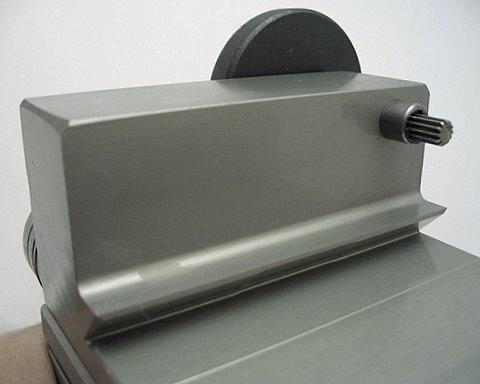
Nice to have lots of metal there and I don't begrudge that, but it is now a little trickier to adjust the eccentric bushing for the pinion shaft - in past, I used to just grab it with thumb and forefinger from underneath. Not something that is done often...
Another shot of the rear apron T-slot
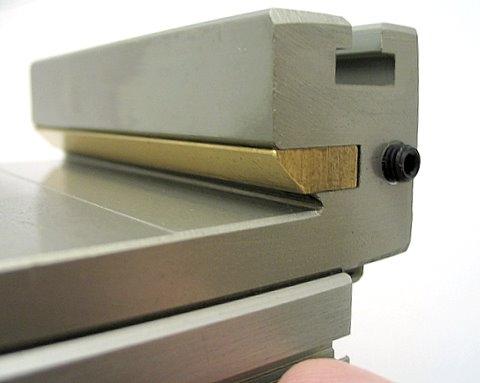
Interesting hole!Note they chamfered its rim
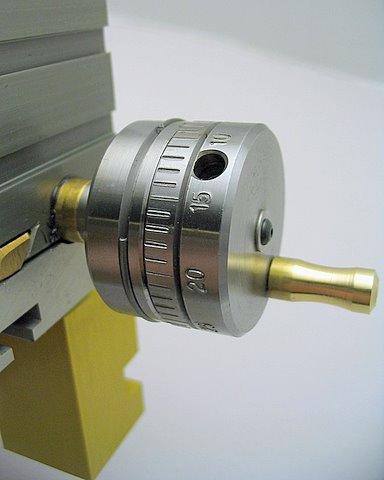 Yes this pic's upside down!
Yes this pic's upside down!
This photo looks like a CAD drawing...
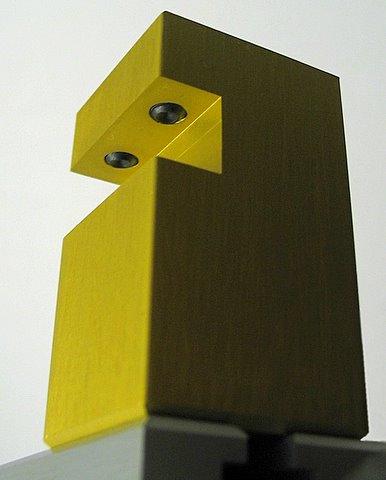 Well - it's not!
Well - it's not!
My point in showing this picture however... was to show that Taig has stopped leaving those very rugged bottoms on the setscrew holes.
This has saved me from needing to file them flush in order to use large tool blanks, knurler handles, etc. as in past.
Note also that the bottom of the toolpost is chamfered around the four sides. My original toolposts didn't have this feature - top or bottom. In the old days they kept the top of the main mounting bolt flush with the top surface of the toolpost - this present example is counterbored to allow the bolt head to be recessed.
Anyhow, the new carriage seems to be good. It is certain to add extra stability and offers frictionless movement in the cross slide handwheel, although I never had any problems that way in past. The extra travel is an asset on large jobs. The colour and general appearance of the unit looks good on the lathe. It will be interesting to see how the anodized aluminum survives as a bearing surface against the steel bed. I know Taig uses the same arrangement in the mill, but the mill table is less exposed compared to a lathe, reducing the ingress of chips and dust.
It seems to be a nice piece of design and addresses the past shortcoming of a limited cross slide travel. In the process Taig has added an extra quarter-inch of extra length to both the bed and cross slide dovetail contact area. This is certain to add a lot of stability to an already sturdy setup. New gib adjustments with lockscrew arrangement, a ball bearing leadscrew handwheel and extra mounting slots add up to round out the improvements. This new anodized carriage, matching the cross slide in color and looking every bit as sturdy as it actually is, gives the Taig lathe a very credible appearance.
Back to the Taig Lathe